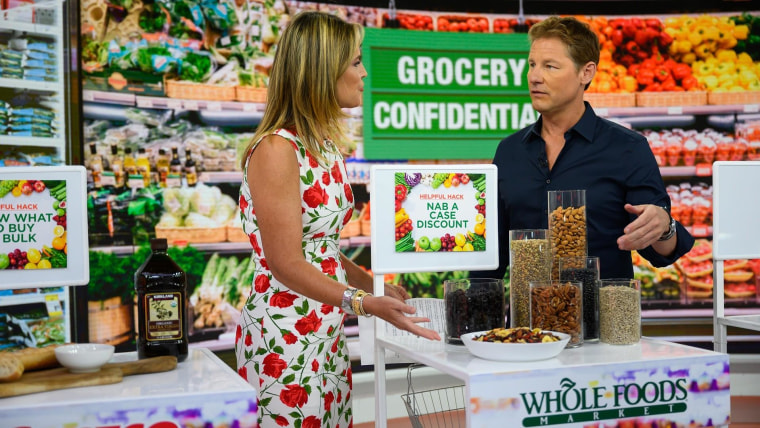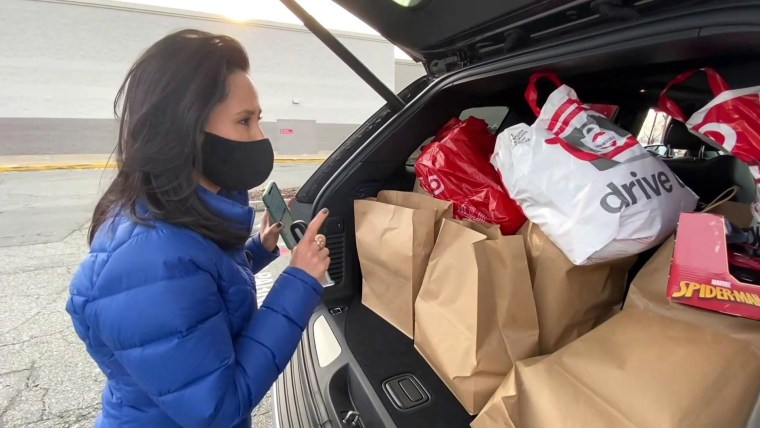Grocery shopping is a part of weekly (and often daily!) life for most Americans. But are you shopping like a pro? There are some simple strategies you can use to get in and out of the store quicker all while saving money and sticking to your nutritional goals.
The best time and day to go grocery shopping
We all know that going food shopping while hungry can lead to some bad nutritional choices that can cost you extra money and expand your waistline. (We see you, Cool Ranch Doritos.) But did you know that the time when you go shopping can also have a big impact on the shopping experience?
According to Google Maps data, Mondays at 8am is the least busy time to shop while Saturdays between 12-3pm is the busiest time (which makes sense since many people put off shopping until the weekend). Shopping at off-peak times will not only help you avoid the crowds, it will also give you more time to comparison shop, said Bonnie Taub-Dix, RDN, creator of BetterThanDieting.com and author of “Read It Before You Eat It – Taking You from Label to Table.”
“I encourage people to comparison shop and look at the difference in cost and labels and how much you’re getting for the same price,” she told TODAY Food. Going early in the morning may also help you get fresh picks, she said. “There may be an abundance of food, especially in the produce aisle. If you’re shopping for freshly prepared items they may run out if you shop later.”
Google can provide you with the busiest and slowest times for shopping at different stores. Just enter your local store in the search bar and you’ll get details on how busy the store is at that time and day.
Make a list (and check it twice!)
Do you envy people who can open their fridge to see it fully stocked with all items neatly stored (and no “science experiments” in old containers)? It is possible to achieve, with a little planning.
“Before grocery shopping each week, sit down with your calendar and map out your daily menus, taking into account your schedule,” said Rachel Cuomo, RD, of Kiwi Nutrition Counseling. “You can then create your shopping list based on this. Everyone’s nutritional goals are different but a good rule of thumb is shop the perimeter of the store, focus on vegetables, fruits, lean proteins, legumes and whole grains, and try to limit purchases in the processed food aisles and bakery section.” Cuomo repeats that tried-and-true advice to never go grocery shopping while hungry. “Remember, it’s easier to say no to cookies one time in the store rather than every time you open the kitchen pantry.”
When shopping, be sure to stock up on pantry staples. And even if you’re not into meal planning it still makes sense to get what you need for at least a few recipes you know you’ll be making each week.
Taub-Dix has a genius hack for never forgetting an item and avoiding buying duplicates of what you already have at home: “Take a picture of your pantry before you go to the store,” she said. “This way you can see what you already have.”
Another strategy she likes is to map out the aisles of her regular grocery store and make a list aisle by aisle in order to shop more efficiently.
Taub-Dix said it’s always a great idea to check supermarket circulars for ways to save. Another idea is to buy items that are on sale in bulk. This works great for canned and frozen foods which will keep for a long time.
“When you buy frozen strawberries you’ll still get the same nutritional benefit,” she said. Taub-Dix said that if you plan to buy in bulk at big box stores, just make sure you have a use for what you’re purchasing.
“You may pay half the price for twice as much and then throw it out,” she said.
“Shop seasonally and don’t buy pre-cut or prepared foods,” said Cuomo. “Skip organic for any foods with a hard exterior like pineapples and avocados.”
Read those labels
Food labels can be difficult to decipher, and most people don’t have the time or desire to stand in the store decoding labels.
“Try not to feel overwhelmed by the food labels,” said Taub-Dix. “Think about what items on the label are relevant to you. If you have high blood pressure, check the sodium. If you have diabetes, pay attention to the sugar on the label. It’s good to know which parts of the label speak to you depending on your needs.”
Stay COVID-safe
In addition to wearing your mask to the store and disinfecting your shopping cart with provided wipes, be sure to take advantage of special shopping hours if that applies to you.
“A lot of the stores have additional times for seniors to shop in the early morning,” said Taub-Dix.
While it isn’t essential to wipe down groceries once you get home, you should avoid touching products you don’t plan to purchase, the CDC advises.
Use touchless forms of payment whenever possible and if you’re at high-risk, try using online ordering or BOPIS (buy online pick up in store) options which many stores now have.
Try something new
One way to make your grocery shopping experience brighter is to get excited about new products. You can follow your favorite grocery stores on Instagram and many stores have a bulletin or newsletter, like Trader Joe’s Fearless Flyer, where you can see what’s new and in season.
Time your food shop right, check for sales and stick to the list (for the most part!) and you’ll find that food shopping can actually be a pleasurable experience!






More Stories
You Just Don’t Know When Your Remarks Will Be Asked for – Unprepared Of Training course!
Ham Radio Q Codes
The 7 Very best Sites To Buy And Sell Your Vehicle On-line